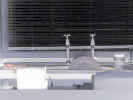If You Are Renovating Your Kitchen, Consider Laminate Flooring Over Hardwoods
Wednesday, November 26, 2008
When choosing flooring for your kitchen, you may find yourself second-guessing hardwood. Although the beauty of hardwood flooring is hard to deny, the eventual cost to maintain it may cancel out your desire for its natural beauty. Unfortunately, wood absorbs moisture which can cause cracking and warping over time. In a worst-case scenario it could even end up cupping or crowning in spots. Your only solutions to these problems are to either sand down the affected section and re-finish, or replace it entirely.
 Since the kitchen demands a flooring material that can withstand high foot traffic, stain-resistance and comfort, laminate flooring may be the perfect solution. There are a myriad of styles and colors available and it is moisture-resistant. Stains can be cleaned quite easily as well. This material is not only affordable, but is relatively simple to install. If you decide upon it, just allow the tiles to sit in their future home for a few days so that they can adjust to the atmosphere they will eventually be installed in. The individual tiles will expand and contract. When installing, don’t forget to leave a quarter of an inch between the wall and the flooring. A wet tile saw is perfect for cutting this material to size. As always, before installation make sure to fill in any holes or dings, and sand away any bumps on your sub-flooring. These things could affect the final result. For help with installation try viewing these DIY instructions.
Since the kitchen demands a flooring material that can withstand high foot traffic, stain-resistance and comfort, laminate flooring may be the perfect solution. There are a myriad of styles and colors available and it is moisture-resistant. Stains can be cleaned quite easily as well. This material is not only affordable, but is relatively simple to install. If you decide upon it, just allow the tiles to sit in their future home for a few days so that they can adjust to the atmosphere they will eventually be installed in. The individual tiles will expand and contract. When installing, don’t forget to leave a quarter of an inch between the wall and the flooring. A wet tile saw is perfect for cutting this material to size. As always, before installation make sure to fill in any holes or dings, and sand away any bumps on your sub-flooring. These things could affect the final result. For help with installation try viewing these DIY instructions.
 Since the kitchen demands a flooring material that can withstand high foot traffic, stain-resistance and comfort, laminate flooring may be the perfect solution. There are a myriad of styles and colors available and it is moisture-resistant. Stains can be cleaned quite easily as well. This material is not only affordable, but is relatively simple to install. If you decide upon it, just allow the tiles to sit in their future home for a few days so that they can adjust to the atmosphere they will eventually be installed in. The individual tiles will expand and contract. When installing, don’t forget to leave a quarter of an inch between the wall and the flooring. A wet tile saw is perfect for cutting this material to size. As always, before installation make sure to fill in any holes or dings, and sand away any bumps on your sub-flooring. These things could affect the final result. For help with installation try viewing these DIY instructions.
Since the kitchen demands a flooring material that can withstand high foot traffic, stain-resistance and comfort, laminate flooring may be the perfect solution. There are a myriad of styles and colors available and it is moisture-resistant. Stains can be cleaned quite easily as well. This material is not only affordable, but is relatively simple to install. If you decide upon it, just allow the tiles to sit in their future home for a few days so that they can adjust to the atmosphere they will eventually be installed in. The individual tiles will expand and contract. When installing, don’t forget to leave a quarter of an inch between the wall and the flooring. A wet tile saw is perfect for cutting this material to size. As always, before installation make sure to fill in any holes or dings, and sand away any bumps on your sub-flooring. These things could affect the final result. For help with installation try viewing these DIY instructions.




